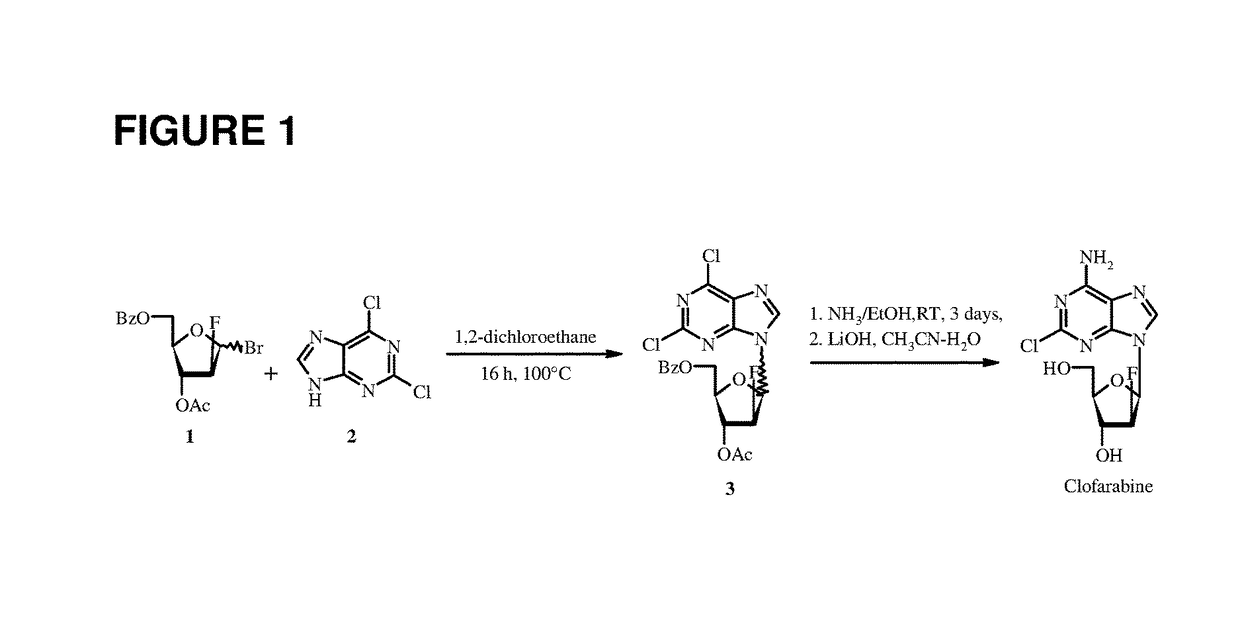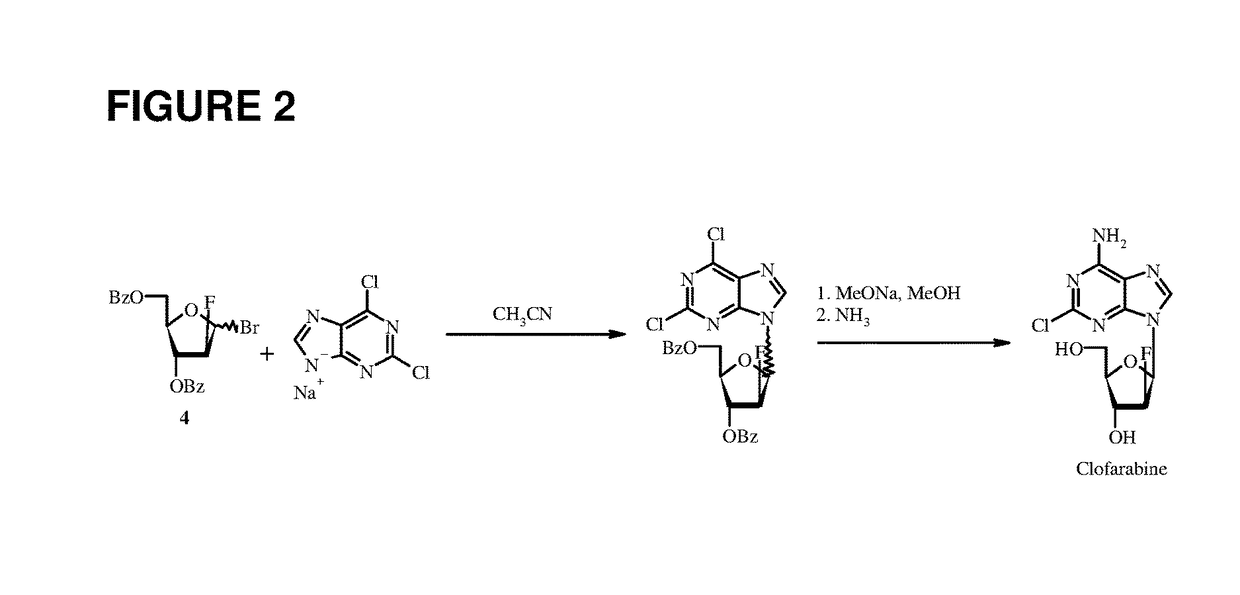Method for the synthesis of clofarabine
a technology of clofarabine and clofarabine, which is applied in the direction of transferases, bulk chemical production, drug compositions, etc., can solve the problems of low overall yield of desired product, low stability of starting bromide 1, and difficulty in coupling purification
- Summary
- Abstract
- Description
- Claims
- Application Information
AI Technical Summary
Benefits of technology
Problems solved by technology
Method used
Image
Examples
example 1a
[0067]Preparation of 2-chloroadenosine (III) from 2-chloroadenine and uridine 400 g of uridine and 150 g of KH2PO4 were dissolved with stirring in a mixture of water (52 l) and DMSO (1.8 l) at 58-61° C. To the resulting solution, a first portion (0.75 l) of a solution prepared from 2-chloroadenine (85 g), water (7 l), and KOH (120 g) was added. The pH of the resulting mixture was adjusted to 7.1-7.2 with aqueous KOH solution. Solutions of uridine phosphorylase and purine nucleoside phosphorylase were added with stirring at 58-61° C. The remaining second portion of the 2-chloroadenine solution was successively added with stirring over a period of 3 hours to the reaction mixture at 58-61° C. keeping pH in the range of 7.1-7.2 with aqueous HCl solution. Afterwards, the reaction mixture was stirred for 1 hour at 58-61° C., and NaOH was added in order to adjust the pH 11.
[0068]The resulting solution containing 2-chloroadenosine was purified by means of preparative chromatography, followe...
example 1b
[0069]Preparation of 2-chloroadenosine (III) from 2-chloroadenine and guanosine 229 g of guanosine and 75 g of KH2PO4 were dissolved with stirring in a mixture of water (521) and DMSO (1.8 l) at 58-61° C. To the resulting solution, a first portion (0.75 l) of a solution prepared from 2-chloroadenine (42 g), water (7 l), and KOH (60 g) was added. The pH of the resulting mixture was adjusted to 7.1-7.2 with aqueous KOH solution. A solution of purine nucleoside phosphorylase was added with stirring to the reaction mixture at 58-61° C. The remaining second portion of the 2-chloroadenine solution was successively added with stirring over a period of 3 hours to the reaction mixture at 58-61° C. keeping pH in the range of 7.1-7.2 with aqueous HCl solution. Afterwards, the reaction mixture was stirred for 1 hour at 58-61° C., and NaOH was added in order to adjust the pH 11.
[0070]The resulting solution containing 2-chloroadenosine was purified by means of low-pressure reverse phase column ch...
example 2
Benzoylation of 2-chloroadenosine
[0071]A solution of 2-chloroadenosine (750 g) in pyridine (7.5 l) was cooled down to −5-0° C. Afterwards, a solution of benzoyl chloride (720 g) in acetonitrile (1440 ml) was slowly added to the reaction mixture with stirring and cooling. Thereby, the internal temperature of the reaction mixture should not be higher than 5° C. The mixture was incubated for 30 min under the same conditions. Thereafter, the solvents were evaporated under reduced pressure at a temperature of 60° C. The residue was dissolved in CH2Cl2. and successively washed with 1M aqueous H2SO4 solution, saturated aqueous NaHCO3 solution, and water. The organic phase was evaporated under reduced pressure to obtain a mixture of 2-chloro-9-(2′,5′-di-O-benzoyl-β-D-ribofuranosyl)-adenine and 2-chloro-9-(3′,5′-di-O-benzoyl-β-D-ribofuranosyl)-adenine (both together about 65% in total by HPLC), as well as 2′,3′,5′-tri-O-benzoyl-2-chloroadenosine (about 30% by HPLC).
PUM
| Property | Measurement | Unit |
|---|---|---|
| temperature | aaaaa | aaaaa |
| temperature | aaaaa | aaaaa |
| temperature | aaaaa | aaaaa |
Abstract
Description
Claims
Application Information
 Login to View More
Login to View More - R&D
- Intellectual Property
- Life Sciences
- Materials
- Tech Scout
- Unparalleled Data Quality
- Higher Quality Content
- 60% Fewer Hallucinations
Browse by: Latest US Patents, China's latest patents, Technical Efficacy Thesaurus, Application Domain, Technology Topic, Popular Technical Reports.
© 2025 PatSnap. All rights reserved.Legal|Privacy policy|Modern Slavery Act Transparency Statement|Sitemap|About US| Contact US: help@patsnap.com



